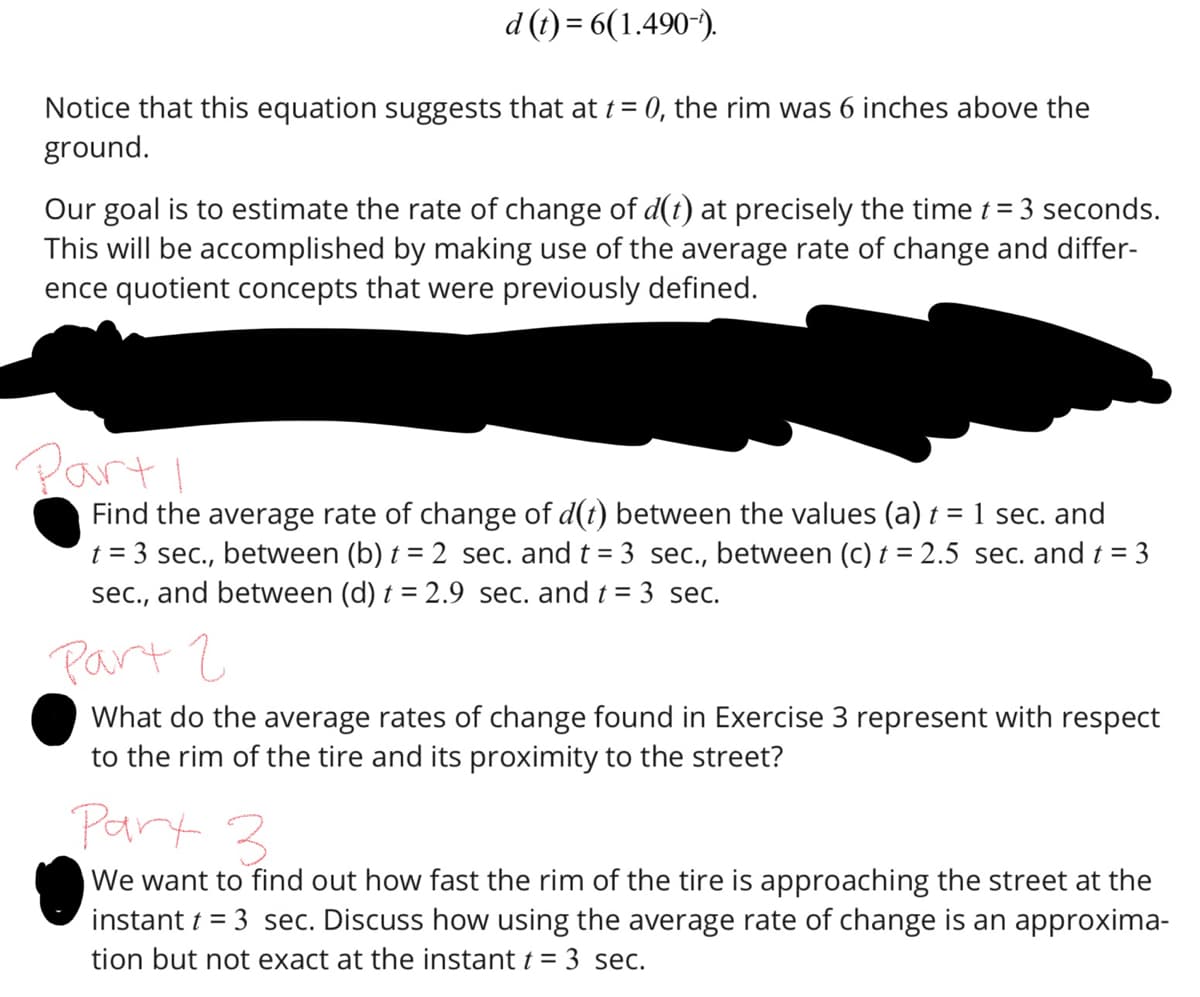1 sec. and Find the average rate of change of d(t) between the values (a) t = t = 3 sec., between (b) t = 2 sec. and t = 3 sec., between (c) t = 2.5 sec. and t = 3 sec., and between (d) t = 2.9 sec. and t = 3 sec.
1 sec. and Find the average rate of change of d(t) between the values (a) t = t = 3 sec., between (b) t = 2 sec. and t = 3 sec., between (c) t = 2.5 sec. and t = 3 sec., and between (d) t = 2.9 sec. and t = 3 sec.
Functions and Change: A Modeling Approach to College Algebra (MindTap Course List)
6th Edition
ISBN:9781337111348
Author:Bruce Crauder, Benny Evans, Alan Noell
Publisher:Bruce Crauder, Benny Evans, Alan Noell
Chapter2: Graphical And Tabular Analysis
Section2.1: Tables And Trends
Problem 1TU: If a coffee filter is dropped, its velocity after t seconds is given by v(t)=4(10.0003t) feet per...
Related questions
Question
Need help
These parts go together

Transcribed Image Text:d (t) = 6(1.490-¹).
Notice that this equation suggests that at t = 0, the rim was 6 inches above the
ground.
Our goal is to estimate the rate of change of d(t) at precisely the time t = 3 seconds.
This will be accomplished by making use of the average rate of change and differ-
ence quotient concepts that were previously defined.
Part I
Find the average rate of change of d(t) between the values (a) t = 1 sec. and
t = 3 sec., between (b) t = 2 sec. and t = 3 sec., between (c) t = 2.5 sec. and t = 3
sec., and between (d) t = 2.9 sec. and t = 3 sec.
Part 2
What do the average rates of change found in Exercise 3 represent with respect
to the rim of the tire and its proximity to the street?
Part 3
We want to find out how fast the rim of the tire is approaching the street at the
instant t = 3 sec. Discuss how using the average rate of change is an approxima-
tion but not exact at the instant t = 3 sec.
Expert Solution
This question has been solved!
Explore an expertly crafted, step-by-step solution for a thorough understanding of key concepts.
Step by step
Solved in 2 steps

Recommended textbooks for you

Functions and Change: A Modeling Approach to Coll…
Algebra
ISBN:
9781337111348
Author:
Bruce Crauder, Benny Evans, Alan Noell
Publisher:
Cengage Learning

Big Ideas Math A Bridge To Success Algebra 1: Stu…
Algebra
ISBN:
9781680331141
Author:
HOUGHTON MIFFLIN HARCOURT
Publisher:
Houghton Mifflin Harcourt

Trigonometry (MindTap Course List)
Trigonometry
ISBN:
9781337278461
Author:
Ron Larson
Publisher:
Cengage Learning

Functions and Change: A Modeling Approach to Coll…
Algebra
ISBN:
9781337111348
Author:
Bruce Crauder, Benny Evans, Alan Noell
Publisher:
Cengage Learning

Big Ideas Math A Bridge To Success Algebra 1: Stu…
Algebra
ISBN:
9781680331141
Author:
HOUGHTON MIFFLIN HARCOURT
Publisher:
Houghton Mifflin Harcourt

Trigonometry (MindTap Course List)
Trigonometry
ISBN:
9781337278461
Author:
Ron Larson
Publisher:
Cengage Learning
